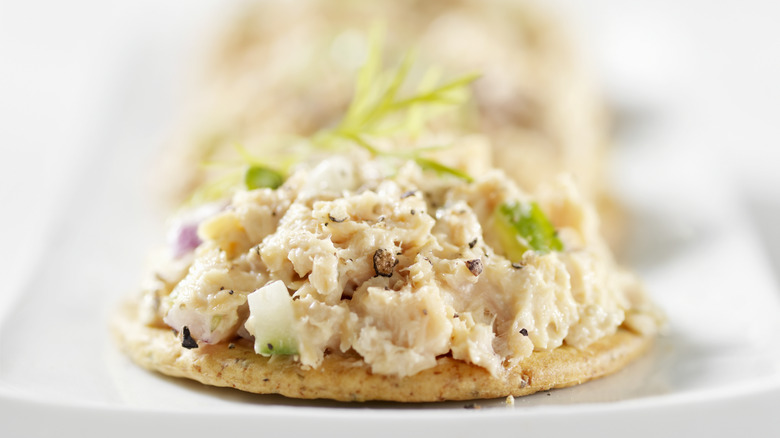Totally Elevate Your Tuna Salad With One Salty Ingredient
Tuna salad is one of those dishes that is simultaneously light and comforting. It seems everyone has their own take on it, whether that's by adding Dijon mustard, pickles, or a little cottage cheese for additional creaminess. There are also many unexpected ingredients to put in tuna salad — but if you're looking for a component to amp up the saltiness factor, there's no better option than soy sauce.
You dip your tuna sushi into soy sauce, right? Now, imagine mixing soy sauce into canned tuna, along with a little onion, celery, and mayonnaise. The result is a crunchy, tangy, creamy sandwich filler that sings with umami essence. If you're seeking a creative way to enhance the depth and saltiness of your tuna salad, soy sauce is an excellent starting point. With a variety of soy sauces available — from light to dark, or even sweet — and attractive ingredient pairings, you can't go wrong.
Different types of soy sauce
When considering which soy sauce to use, it's best to understand the more apparent differences. Chinese soy sauce tends to have a bolder and saltier taste than Japanese soy sauce, or shoyu, which usually offers a slightly delicate, more intricate flavor and a sweeter aftertaste.
If you typically use mayonnaise in your tuna salad and you want the soy sauce to cut through the creaminess, then Chinese soy sauce is a suitable choice. Otherwise, shoyu will impart a nuanced flavor to your tuna salad that doesn't overpower but rather gently unfolds.
It's also worth noting that Kikkoman produces over 300 varieties of soy sauce. Some focus on celebrating the core flavor profile, umami, while others incorporate subtle hints of vanilla, fruits, coffee, and even whiskey. Mixing these flavors into your tuna salad may seem unconventional. If it's your first attempt at mixing a tuna salad with soy sauce, starting with a more standard variety might be less intimidating.
Other ingredients that go hand in hand
To fully embrace the umami flavors in this salad, you can pair the tuna and soy sauce with other Asian-inspired ingredients. For added crunch and tang, consider replacing celery and white onion with scallions, radishes, or nappa cabbage.
Toasted sesame seeds or a touch of sesame oil are also fantastic additions. For a lighter version of tuna salad with no mayonnaise, try substituting it with a mixture of sesame and soy sauce. The nutty silkiness of the sesame beautifully complements the deeper notes of the salty soy sauce, creating a subtly sweet yet intricately savory flavor profile around the tuna.
Additional ingredients to enhance this Asian-inspired tuna salad could include grated ginger for a touch of heat, chilies for a spicy kick, or lime for a hint of acidity. Even the base on which the tuna salad is served could echo these Asian influences. Have you ever considered serving your tuna salad with soba noodles?
Soy sauce serves as the ideal ingredient to elevate the saltiness of your tuna salad and serves as a gateway to Asian flavor combinations, offering a distinctive twist on the usual suspects in your tuna salad.


